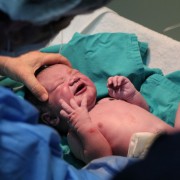When to cut the cord
Clamping the umbilical cord two minutes after birth leads to better newborn outcomes, a new study says

Delaying clamping of the umbilical cord by two minutes after birth – or once cord pulsating has ceased – translates into better development for newborns in the first few days of their lives, a new study suggests.
In the study, published in the journal Pediatrics, researchers from the University of Granada and the San Cecilio Clinical Hospital assessed the impact of clamping timing on newborn outcomes based on two factors - oxidative stress, and the inflammatory signal produced during delivery.
Out of 64 healthy pregnant women who had normal pregnancies and spontaneous vaginal delivery, half had their umbilical cords cut 10 seconds after delivery, and the others had them cut after two minutes.
The results revealed that late clamping of the umbilical cord increases antioxidant capacity and moderates inflammatory effects, which may improve the development of the newborn during his or her first days of life, according to lead author Prof Julio José Ochoa Herrera of the University of Granada, Medical News Today reported.
Current guidelines set by the American Congress of Obstetricians and Gynaecologists (ACOG) indicate that cord clamping should occur within 15-20 seconds after birth, partly because more than 90 percent of blood volume is gained within the first few breaths that infants take after birth.
In October 2014, the World Health Organisation (WHO) made a recommendation that delayed cord clamping should be carried out for all births - with the exception of cases in which the newborn is asphyxiated and requires resuscitation. This practice allows blood flow from the placenta to continue, leading to improved iron status in infants for up to six months after birth, and is “particularly relevant for infants living in low-resource settings, with reduced access to iron-rich foods,” according to the organisation’s website.
However, the ACOG has maintained its concerns regarding delayed cord clamping, which it says may increase the chance of excessive placental transfusion, which can lead to neonatal polycythemia (an abnormally high level of red blood cells); and also that the practice "may be technically difficult in some circumstances", according to the Medical News Today report.
Further links:
Medicalnewstoday.com
News-medical.net
Who.int
Related Articles
The importance of play in a growing child
Playtime has long been a low priority in raising and educating children, but its absence can harm a growing child’s physical and mental health
Read moreStress early in life can affect child’s brain
Stress not only impacts a person’s health and behaviour, but their brain too
Read moreSmartphone use causes paediatric dry eye disease
Excessive smartphone use increases symptoms of dry eye disease and eyestrain among children, researchers suggests
Read moreLatest Articles
Medical Care
Clinical Exercise Physiologist (CEP): The Emerging of Exercise is Medicine
How Exercising can be a Medicine
Read moreMedical Care
Reversing type 2 Diabetes: Embracing Hope and Determination
Experience the remarkable journey of Ash and his grandfather Atok as they conquer type 2 diabetes through unconventional methods, showcasing the power of love and determination over adversity.
Read moreMedical Care
Bladder Cancer: What You Need to Know
Empower yourself with our comprehensive guide to bladder cancer. Explore symptoms, diagnosis, treatments, and supportive resources to safeguard your health.
Read more